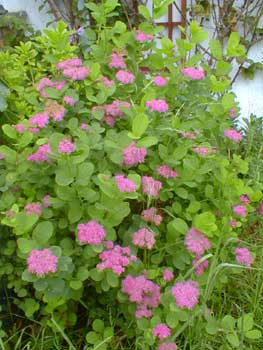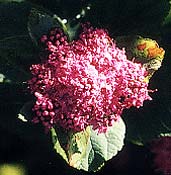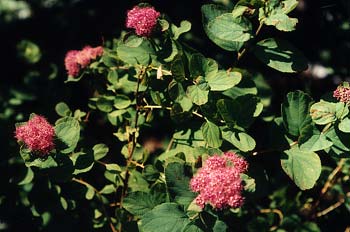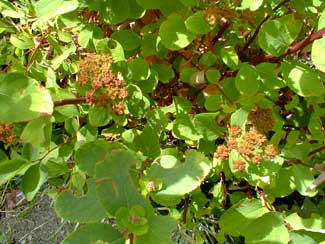
A Northwest Native Shrub:
Mountain Spirea; aka,
Rosy Spirea or Subalpine Spirea
"The stem of a departed Flower
Has still a silent rank.
The Bearer from an Emerald Court
Of a Despatch of Pink."
-Emily Dickinson
(1830-1886)
(1830-1886)
 In its natural habitat 2,000 to 11,000 feet up, Spiraea densiflora blooms in June & July, but down here at sea level, it blooms in May & early June, then reblooms in summer.
In its natural habitat 2,000 to 11,000 feet up, Spiraea densiflora blooms in June & July, but down here at sea level, it blooms in May & early June, then reblooms in summer.The blooms are flat-topped balls of fuzzy-looking teency florets in two- or three-inch clusters, a bit like lacecaps, in a very pleasing shade of pink-magenta.
Spent flower-heads remain on the plant even after leaf-fall & well into winter, as crisp brown balls of seed husks.
This is one of our Northwest native species, encountered in subalpine regions of British Columbia, Washington's Olympic & Cascade mountains, eastern Oregon, northern Idaho, western Montana, & California's northwest Sierran mountains.
 Even here in the Northwest where it is from, it is a rare offering by nurseries, except by native plant specialists, & I assume it's even harder to obtain elsewhere. But if chance arises, it is well worth obtaining, an ideal little shrub for the woodland garden.
Even here in the Northwest where it is from, it is a rare offering by nurseries, except by native plant specialists, & I assume it's even harder to obtain elsewhere. But if chance arises, it is well worth obtaining, an ideal little shrub for the woodland garden.I like it much better than any of the commonly cultivated garden spireas. Its bright green leaves add essential texture to an array of shrubs.
Ours is snuggled amidst mid-sized azaleas, breaking up what might otherwise have been a monotonous grouping.
Its autumn colors are nothing special, though the browned seedheads can remain suprisingly decorative late in the year, & of interest to finches. August seeds are shown in the fourth photo below.
Often, by June & later, it will have these brown seedheads & fresh pink flowers simultaneously, since its bloom time is so extended. I used to try to trim out the seedheads but the shrub was too floriferous for such a time-consuming chore, so I've gotten more & more to regard the seeds heads as themselves nice brown flowers.
 Further south or inland, especially in any climate where it does not experience a cool enough winter, it might not flower well if at all. But our mild Zone 8 winters do provide the seasonal cues it requires, so that it flowers dramatically over a long period. It should do just as splendidlly in the Northeast or in English & European gardens.
Further south or inland, especially in any climate where it does not experience a cool enough winter, it might not flower well if at all. But our mild Zone 8 winters do provide the seasonal cues it requires, so that it flowers dramatically over a long period. It should do just as splendidlly in the Northeast or in English & European gardens.Our Rosy Spirea is a tad over three feet tall, which is a very mature size. It can easily spread wider but will not likely grow much if any taller; indeed, some specimens would not exceed two feet.
A light post-flower sheering encourages a more dramatic rebloom. A fuller winter sheering while not necessary will keep it compact & insures maximum flowerfulness the following season. It may need a harder pruning every third year if it seems too airy & insufficiently leafy or has had a falling off of floweriness.
It likes full bright sun, moist acidic soil. In the wild it would form spreading thickets along streambanks & exposed rocky slopes. Adaptable in the garden, it can colonize & spread if ignored, but never aggressively. When young plants appear nearby, these transplant easily.
A tea can be made from the leaves, twigs, bark, & flowers of Rosy Spirea, as also from the taller bottlebrush-flowered Douglas's Spirea (S. douglasii) which replaces S. densiflora at lower elevations. Native Americans regarded the tea as a tonic & a treatment for loose bowels. The twigs were often gathered upon which to cook or smoke salmon. The native spireas & rose-family shrubs generally were also used as tobacco substitutes or to cut Kinnikinnik in native smoking blends.